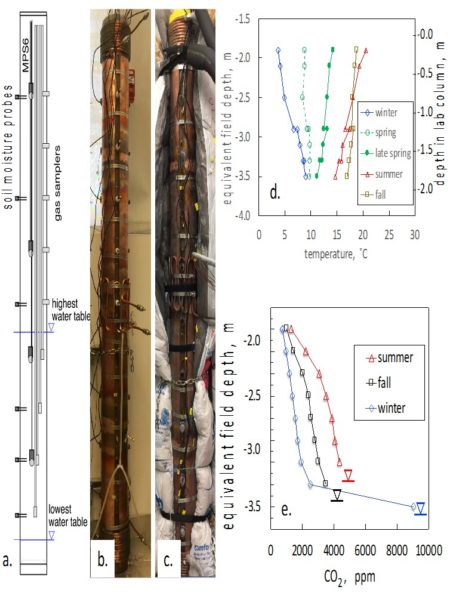
2.0 m tall laboratory sediment column and example measurements. a. instrument distribution, b. column clad with heat exchangers, c. column with insulation sleeve, d. seasonal field temperature profiles replicated in column, e. seasonal CO2 profiles from laboratory column.
Fluid flows with temperatures that are not constant are known as non-isothermal. Although changing thermal and hydrological conditions control rates of sediment biogeochemical processes in the Earth’s subsurface, these conditions are difficult to simulate in the laboratory. In this study, a novel 2 m tall column system to control time- and depth-dependent temperature profiles and water saturation was developed, which is needed to more accurately reproduce subsurface processes in the laboratory.
Temperature and moisture profiles in sediments are highly variable, and control biogeochemical processes, yet have not previously been reproduced in the laboratory. This study established field temperature and moisture profiles in a laboratory column system, and showed the importance of microbial respiration below the plant root zone by measuring CO2 production within the sediment column.
Summary
Transport between the soil surface and groundwater is commonly mediated through deeper portions of variably saturated sediments and the capillary fringe, where variations in temperature and water saturation strongly influence biogeochemical processes. Temperature control is particularly important because room temperature is not representative of most soil and sediment environments. The authors described and tested a novel sediment column design that allows laboratory simulation of thermal and hydrologic conditions found in many field settings. The 2.0 m tall column was capable of replicating temperatures varying from 3 to 22 ˚C, encompassing the full range of seasonal temperature variation observed in the deep, variably saturated sediments and capillary fringe of a semi-arid floodplain in western Colorado, United States. The water table was varied within the lower 0.8 m section of the column, while profiles of water content and matric (capillary) pressure were measured. CO2 collected from depth-distributed gas samplers under representative seasonal conditions reflected the influences of temperature and water-table depth on microbial respiration. Thus, realistic subsurface biogeochemical dynamics can be simulated in the laboratory through establishing column profiles that more accurately represent seasonal thermal and hydrologic conditions.
Citation
Tokunaga, T.K., Y. Kim, J. Wan, M. Bill, M. Conrad, and W. Dong, “Method for Controlling Temperature Profiles and Water Table Depths in Laboratory Sediment Columns. Vadose Zone Journal 17,180085 (2018). [DOI: 10.2136/vzj2018.04.0085]
